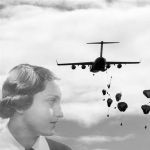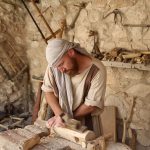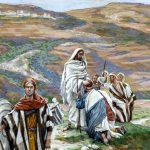
In 2012, Prime Minister Benjamin Netanyahu presented Johan van Hulst with a Hebrew Bible and appreciation on behalf of Israel for saving Jewish lives. (CIDITV YouTube Capture)
In memory of Johan Van Hulst,
who went home to be with the Lord
on March 22, 2018 at the age of 107.
It’s May of 1943, Amsterdam. The Nazis have occupied the Netherlands for three years and have been rounding up the Jews since summer of 1942.
Men and women are taken to the local theatre. Their babies and children under 13 are being placed in the nursery across the street.
Thirty-two-year-old Johan Van Hulst directed the Christian seminary next door to the nursery where the children were being held for impending death.
He wanted to help. But how?
He recalled the Book of Esther in the Bible, which recounts how a Jewish girl became queen and interceded to save a whole generation of Jews.
“I thought: I am the director of this school. This school is adjacent to the nursery, the gardens seamlessly blend. I thought: maybe I was put in this place to do something,” van Hulst said in an interview at age 101. (nrc, translated)
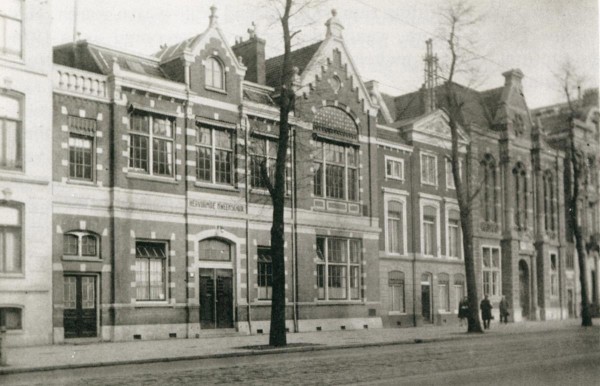
1925 photo of the Christian Kweekschool (left), which Johan van Hulst directed and the nursery to the right of the school, with the white window frames. (Joods Cultureel Kwartier, fair use)
In his role as the school’s director since 1942, Van Hulst allowed the facility to become a critical link between death and freedom for as many as 1,000 children.
He recalled that the deportation process began with a raid of Jewish homes, facilities, and neighborhoods. Jewish adults were taken to the theatre across the street from his school, while their children were taken to the nursery next door to the school.
“The children were not yet registered at that time,” said van Hulst. “If the Germans, for example, brought 32 children [to the nursery], we [members of the resistance team] entered on the list that there were only 25.” (noc, translated)
One of these children was 4-year-old Lies Caransa: “I was not allowed to say goodbye and did not hug my mother and grandmother because that might have caused a scene. I just waved. I felt alone and lonely.” (nrc, translated)
A hedge connected the garden of the nursery to the garden of van Hulst’s school.
Lies recalls, “I was lifted over a wall and put in a jute bag, which I thought was awful, but as a child I realized that I should not cry or scream. To date, I cannot bear the smell of jute, which reminds me of desolation, anxiety, and fear.”
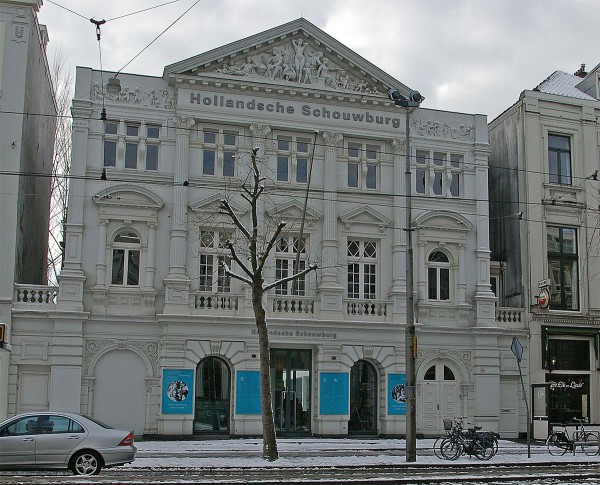
Hollandsche Schouwburg was a luxurious theatre in a vibrant Jewish neighborhood of Amsterdam. Here, 80,000 Jews were collected between 1942–1943 for deportation to death camps. It is now the National Holocaust Memorial of the Netherlands.
Resistance groups and university students smuggled the children out of the school in laundry bags or baskets.
At times, they would wait for the streetcar to stop in front of the school, blocking the sight of the Nazi guards at the theatre across the street, and cycle away with a child in the bag or basket. Or they might get on the car itself with a child.
The resistance groups placed the children with families, both Protestant and Catholic, often in the countryside. Lies was placed with a good friend of her mother, who had contacted the resistance group beforehand.
Johan van Hulst and the resistance team didn’t take children without the consent of their parents.
He recalled how a mother refused to let her children go, saying, “They need a strong mother.” Sighing, Van Hulst said, “They were all killed. I had read Mein Kampf in 1933. In the chapter ‘I Am an Anti-Semite,’ it says that he [Hitler] will destroy ‘the rats of society.’ I knew it. But the people were blinded.” (nrc)
Nearly all of the adults transported through the theatre were murdered in the Nazi extermination camp located at Sobibor, Poland, including Lies’ family members. But, gratefully, her mother survived a deportation to Auschwitz.
With two daughters of his own, aged four and six, the operation was especially risky. Van Hulst could have been sentenced for treason and perhaps his entire family taken prisoner and executed, as happened to other resistance members. That weighed heavily on him, but he said, “I had to do it.”
“You knew that every child you did not help was dead, some of the adults had come back, not one of the children; it was unimaginable,” said van Hulst.
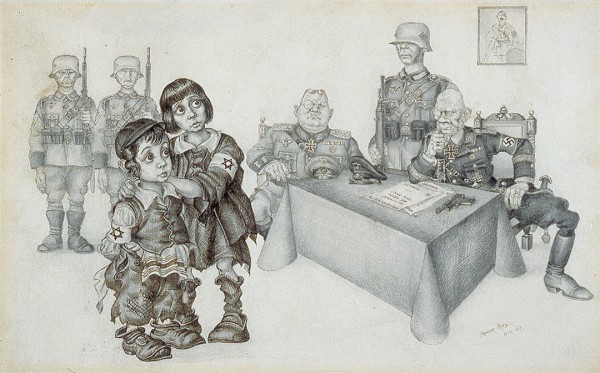
This 1943 illustration by Arthur Szyk tried to spread the truth that innocent Jewish children were being condemned to die by the Nazis. The drawing first appeared in the PM New York Daily newspaper and later on prints and fundraising stamps for Peter H. Bergson’s Emergency Committee to Save the Jewish People of Europe. (USHMM)
The first children to be lifted over the garden’s hedge with the help of local university students began in May 1943.
“It started with the request of the [nursery] director Henriëtte Pimentel to allow children to sleep in the garden. Soon we put beds in a room … It is incomprehensible that the Nazis never noticed anything. What we did was probably too bold to be true.”
When a Dutch Education Ministry inspector heard babies crying and asked if they were Jewish, van Hulst replied, “You don’t really expect me to answer that, do you?”
The government official replied, “In God’s name, be careful,” and walked away without reporting it, recalled van Hulst. (Smithsonian)
Yet, Hulst doesn’t consider himself a hero. Rather, he saw his actions as a duty:
“It cannot be said of me: ‘He was there and he looked at it.’ I saw what was going on; I saw what kind of help was needed and I tried to help, albeit to a modest extent, where possible.”
“For me the war never goes away. I have seen with my own eyes how all those children left on train 9, and how two Nazis picked up a Jewish girl’s toy doll. Those images are forever burnt on my retina.” (2011 interview, nrc translated)
Sixty years later, it still deeply distressed van Hulst that he did not save at least one more child.
“Try to imagine 80, 90, perhaps 70 or 100 children standing there, and you have to decide which children to take with you…. That was the most difficult day of my life,” he recalled of the time in 1943 when the nursery was to be cleared out. (Smithsonian)
“You realize that you cannot possibly take all the children with you. You know for a fact that the children you leave behind are going to die. I took 12 with me. Later on I asked myself: ‘Why not 13?'”
At age 101, van Hulst met Israeli Prime Minister Benjamin Netanyahu, who presented him with a Hebrew Bible and comforted him with these words:
“We say, those who save one life saves a universe. You saved hundreds of universes. I want to thank you in the name of the Jewish people, but also in the name of humanity.”
Van Hulst, by all accounts, should not have lived beyond age 34, since he had been sentenced to death in 1945 by the Germans (in absentia) for saving Jewish lives. But a knock came on the door of the school. A woman he did not know warned that the Germans were coming for him.
He fled to his parents’ home and remained there without being discovered until after the war ended in September of that year.
At the age of 61, van Hulst received the honor of Righteous Among the Nations by Israel’s Yad Vashem Holocaust Memorial organization—an honor bestowed on non-Jews who risked their lives to save Jewish People in the Holocaust.
As well, the Dutch film Süskind (2012) recounts the heroic efforts of van Hulst along with Walter van Süskind, a Jewish member of the Dutch Judenrat (Jewish Council), appointed by the Nazis to manage the Hollandsche Schouwburg theatre operation.
In that trusted capacity, Süskind could adjust the records and help coordinate rescue efforts between the nursery, school, and resistance groups.
Salvation required teamwork and strategy.
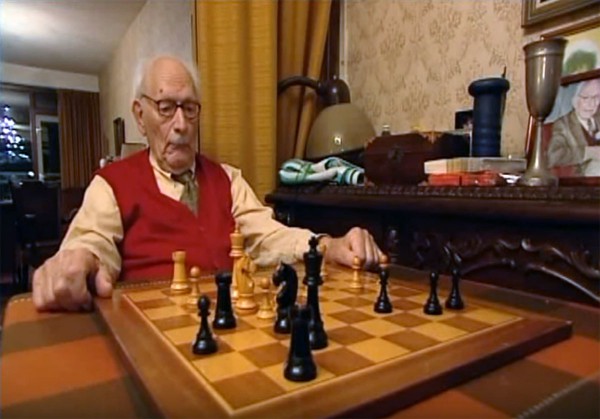
Johan van Hulst was an avid chess player, winning the Corus Chess Tournament for (former) Dutch politicians at the age of 95 and again at 99. (Max Euwe Center Amsterdam YouTube capture)
Lessons for Today
Even with the courage of people like Hulst, Süskind, and some 5,593 other Righteous Gentiles in the Netherlands, the second highest in the world (next to Poland), this nation with 140,000 Dutch and immigrant Jews also had the lowest rate of Holocaust survival in Western Europe — about 27%. (Netherlands Ministry of Justice)
Belgium had nearly 60 percent survival; France, 75 percent.
One important reason for this difference is the high rate of naiveté among the Dutch regarding the motives of the Nazis to exterminate the Jews.
The Dutch people had been relatively free of anti-Semitism before the war, so they did not conceive that man could plot such evil against Jews just because they were Jews.
They chose not to hear or believe the clear plans for Jewish eradication in Hitler’s writings and speeches. Just as people today don’t hear or believe Iran’s clear plans to launch nuclear weapons into Israel to exterminate the Jewish people.
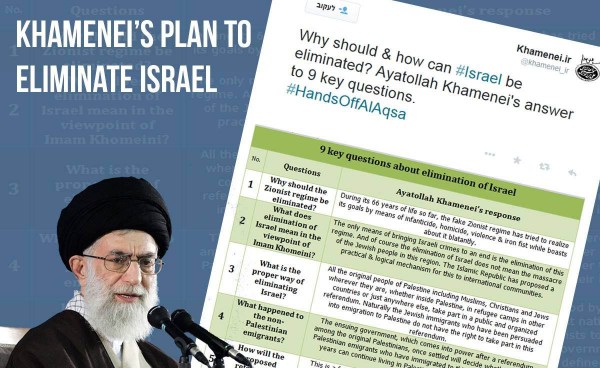
Iran’s Supreme Leader, Ayatollah Khamenei published a nine-point plan to eliminate Israel on Twitter, November 4, 2014.
Moreover, the Dutch people had a high sense of duty to their governing authority, so Jewish citizens generally cooperated with the Nazis, even after deportations began, still not believing that death would meet them at the end of their train ride.
Another factor that gave the people a false sense of security is that the Nazis did not immediately deport the Jews when they took control of the Netherlands in 1940. Rather, Jews were appointed to serve on councils, which helped the German administration update their records of the Jewish People in the nation, making it easier for deportation when the time came in 1942.
Likewise, the Iranian regime has used naive leaders in Europe and the US to make it easier for them to produce the weapons necessary to exterminate Israel, such as with the signing of the Iranian Nuclear Deal.
Johan Van Hulst, however, was not naive. He understood the true motives of the Nazi regime, the risks for resisting; and yet, he still took advantage of his position (as Queen Esther did) to save as many lives as possible.
He continued serving his fellow man as a senator in the Dutch Parliament from 1956 until 1981. During the last thirteen years of that service, he led the nation’s Christian political party.
At the age of 107, Van Hulst entered eternal peace with His Lord and Savior, Jesus, the Messiah. We believe that upon arrival he heard the words, “Well done, good and faithful servant.” (Matthew 25:21)







